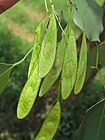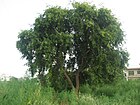Note: This is a project under development. The articles on this wiki are just being initiated and broadly incomplete. You can Help creating new pages.
Difference between revisions of "Dalbergia sissoo - Simsapa"
(→External Links) |
|||
| (11 intermediate revisions by 2 users not shown) | |||
| Line 1: | Line 1: | ||
[[File:Leaflet of (Dalbergia sissoo) North Indian rosewood tree.jpg|thumb|right|''Simsapa', ''Dalbergia sissoo'']] | [[File:Leaflet of (Dalbergia sissoo) North Indian rosewood tree.jpg|thumb|right|''Simsapa', ''Dalbergia sissoo'']] | ||
| − | ''' | + | '''Dalbergia sissoo''' is a deciduous medium-sized tree growing up to 30 metres tall. The bole is often crooked and branchless for up to 8 metres, occasionally for as much as 20 metres. It is a valuable timber in India, where it can fetch the same prices as teak. It is cultivated as a forest tree in southern Asia and tropical Africa. |
| − | |||
==Uses== | ==Uses== | ||
{{Uses|Worm infestation}}, {{Uses|Emaciation}}, {{Uses|Skin diseases}}, {{Uses|Urinary tract disorders}}, {{Uses|Ulcers}}, {{Uses|Blood disorders}}, {{Uses|Inflammation}} | {{Uses|Worm infestation}}, {{Uses|Emaciation}}, {{Uses|Skin diseases}}, {{Uses|Urinary tract disorders}}, {{Uses|Ulcers}}, {{Uses|Blood disorders}}, {{Uses|Inflammation}} | ||
| Line 12: | Line 11: | ||
==Common names== | ==Common names== | ||
| − | {{Common names|kn= | + | {{Common names|kn=Agaru, Birade, Karimara, Nooke mara, Shishmabage|ml=Rupul, Iruvil, Pivala-sesba, Sisam, Sissu, tali|sa=Aguru, Kapila-sinsapa, Pichhila, Pipala, Shingshupa, Simsapa|ta=Cicumaram , Tesimaram|te=Errasissu, Sissu, Sissu-karra|hi=Shisham, Sissu|en=Shisham}} |
<ref name="Common names"/> | <ref name="Common names"/> | ||
| Line 36: | Line 35: | ||
==Identification== | ==Identification== | ||
===Leaf=== | ===Leaf=== | ||
| − | {{Leaf|Pinnate| | + | {{Leaf|Pinnate|Alternate|Leaves imparipinnate; leaflets 3-5, 2.5-6 x 2-5.5 cm, ovate, obovate or orbicular, base rounded to cuneate, apex cuspidate or acuminate, coriaceous, puberulous to pubescent when young, glabrous when mature; petiolules 3-5 mm long.}}<ref name="Leaf"/> |
===Flower=== | ===Flower=== | ||
| − | {{Flower|Bisexual|Axillary or terminal panicle|Cream|9| Flowers cream coloured, 6-8 mm long, subsessile. Calyx 4-6 mm long, campanulate, puberulous without; lobes oblong. Petals exserted; standard to 8 x 5 mm, obovate, long-clawed. Stamens 9, monadelphous. Ovary long-stipitate, pubescent}} | + | {{Flower|Bisexual|Axillary or terminal panicle|Cream|9|Flowers cream coloured, 6-8 mm long, subsessile. Calyx 4-6 mm long, campanulate, puberulous without; lobes oblong. Petals exserted; standard to 8 x 5 mm, obovate, long-clawed. Stamens 9, monadelphous. Ovary long-stipitate, pubescent}} |
===Fruit=== | ===Fruit=== | ||
| − | {{Fruit|A Pod|2.5-7 x 0.8-1 cm| | + | {{Fruit|A Pod|2.5-7 x 0.8-1 cm|Linear-oblong, base cuneate, apex acute|Seeds 1-3|}} |
===Other features=== | ===Other features=== | ||
==List of Ayurvedic medicine in which the herb is used== | ==List of Ayurvedic medicine in which the herb is used== | ||
| − | + | * [[Ayaskriti]] | |
| + | * [[Asanadi kashayam]] | ||
| + | * [[Narasimha rasayana]] | ||
| + | <ref name="Ayurvedic preparations"/> | ||
==Where to get the saplings== | ==Where to get the saplings== | ||
==Mode of Propagation== | ==Mode of Propagation== | ||
| − | {{Propagation|Seeds}}, {{Propagation| | + | {{Propagation|Seeds}}, {{Propagation|Suckers}}. |
==How to plant/cultivate== | ==How to plant/cultivate== | ||
| − | + | Directly sown seed attain 15-25 cm after the first rains, 90-120 cm after the second rains in India. For seedling transplantation, only tender plants with small taproots should be used. Root suckers transplant satisfactorily in dry climates. Planting should be in spring (March in India). | |
| − | = | + | <ref name="Cultivation details"/> |
| − | |||
| − | |||
| − | |||
| − | |||
| − | |||
==Commonly seen growing in areas== | ==Commonly seen growing in areas== | ||
| Line 78: | Line 75: | ||
<references> | <references> | ||
| − | <ref name="Uses">https://easyayurveda.com/2015/10/15/dalbergia-sissoo-sisham-shimshapa/ | + | <ref name="Uses">[https://easyayurveda.com/2015/10/15/dalbergia-sissoo-sisham-shimshapa/ Uses]</ref> |
| − | <ref name="Leaf">[http://FLOWERING PLANTS OF KERALA VER.2, N. Sasidharan | + | <ref name="Leaf">[http://FLOWERING PLANTS OF KERALA VER.2, N. Sasidharan BOTANIC DESCRIPTION]</ref> |
| − | <ref name="Common names">[http://envis.frlht.org/bot_search | + | <ref name="Common names">[http://envis.frlht.org/bot_search Vernacular names]</ref> |
| + | <ref name="Ayurvedic preparations">[https://easyayurveda.com/2015/10/15/dalbergia-sissoo-sisham-shimshapa/ Ayurvedic preparations]</ref> | ||
| + | <ref name="Cultivation details">[https://hort.purdue.edu/newcrop/duke_energy/Dalbergia_sissoo.html#Cultivation Cultivation details]</ref> | ||
| Line 87: | Line 86: | ||
==External Links== | ==External Links== | ||
| − | * http://tropical.theferns.info/viewtropical.php?id=Dalbergia+sissoo | + | * [http://tropical.theferns.info/viewtropical.php?id=Dalbergia+sissoo Dalbergia sissoo on theferns.info] |
| − | * https://keys.lucidcentral.org/keys/v3/eafrinet/weeds/key/weeds/Media/Html/Dalbergia_sissoo_(Indian_Rosewood).htm | + | * [https://keys.lucidcentral.org/keys/v3/eafrinet/weeds/key/weeds/Media/Html/Dalbergia_sissoo_(Indian_Rosewood).htm Dalbergia sissoo on lucidcentral.org] |
| − | * http://www.ijrpc.com/files/32-3111.pdf | + | * [http://www.ijrpc.com/files/32-3111.pdf Dalbergia sissoo on ijrpc.com] |
[[Category:Herbs]] | [[Category:Herbs]] | ||
| − | [[Category: | + | [[Category:Fabaceae]] |
Latest revision as of 15:17, 23 April 2020
Dalbergia sissoo is a deciduous medium-sized tree growing up to 30 metres tall. The bole is often crooked and branchless for up to 8 metres, occasionally for as much as 20 metres. It is a valuable timber in India, where it can fetch the same prices as teak. It is cultivated as a forest tree in southern Asia and tropical Africa.
Contents
- 1 Uses
- 2 Parts Used
- 3 Chemical Composition
- 4 Common names
- 5 Properties
- 6 Habit
- 7 Identification
- 8 List of Ayurvedic medicine in which the herb is used
- 9 Where to get the saplings
- 10 Mode of Propagation
- 11 How to plant/cultivate
- 12 Commonly seen growing in areas
- 13 Photo Gallery
- 14 References
- 15 External Links
Uses
Worm infestation, Emaciation, Skin diseases, Urinary tract disorders, Ulcers, Blood disorders, Inflammation [1]
Parts Used
Chemical Composition
Common names
| Language | Common name |
|---|---|
| Kannada | Agaru, Birade, Karimara, Nooke mara, Shishmabage |
| Hindi | Shisham, Sissu |
| Malayalam | Rupul, Iruvil, Pivala-sesba, Sisam, Sissu, tali |
| Tamil | Cicumaram , Tesimaram |
| Telugu | Errasissu, Sissu, Sissu-karra |
| Marathi | NA |
| Gujarathi | NA |
| Punjabi | NA |
| Kashmiri | NA |
| Sanskrit | Aguru, Kapila-sinsapa, Pichhila, Pipala, Shingshupa, Simsapa |
| English | Shisham |
Properties
Reference: Dravya - Substance, Rasa - Taste, Guna - Qualities, Veerya - Potency, Vipaka - Post-digesion effect, Karma - Pharmacological activity, Prabhava - Therepeutics.
Dravya
Rasa
Tikta (Bitter), Kashaya (Astringent), Katu (Pungent)
Guna
Laghu (Light), Rooksha (Dry)
Veerya
Ushna (Hot)
Vipaka
Katu (Pungent)
Karma
Kapha, Vata
Prabhava
Habit
Identification
Leaf
| Kind | Shape | Feature |
|---|---|---|
| Pinnate | Alternate | Leaves imparipinnate; leaflets 3-5, 2.5-6 x 2-5.5 cm, ovate, obovate or orbicular, base rounded to cuneate, apex cuspidate or acuminate, coriaceous, puberulous to pubescent when young, glabrous when mature; petiolules 3-5 mm long. |
Flower
| Type | Size | Color and composition | Stamen | More information |
|---|---|---|---|---|
| Bisexual | Axillary or terminal panicle | Cream | 9 | Flowers cream coloured, 6-8 mm long, subsessile. Calyx 4-6 mm long, campanulate, puberulous without; lobes oblong. Petals exserted; standard to 8 x 5 mm, obovate, long-clawed. Stamens 9, monadelphous. Ovary long-stipitate, pubescent |
Fruit
| Type | Size | Mass | Appearance | Seeds | More information |
|---|---|---|---|---|---|
| A Pod | 2.5-7 x 0.8-1 cm | Linear-oblong, base cuneate, apex acute | Seeds 1-3 | {{{6}}} |
Other features
List of Ayurvedic medicine in which the herb is used
Where to get the saplings
Mode of Propagation
How to plant/cultivate
Directly sown seed attain 15-25 cm after the first rains, 90-120 cm after the second rains in India. For seedling transplantation, only tender plants with small taproots should be used. Root suckers transplant satisfactorily in dry climates. Planting should be in spring (March in India). [5]
Commonly seen growing in areas
Tropical area, Sub tropical area
Photo Gallery
References
External Links
- Ayurvedic Herbs known to be helpful to treat Worm infestation
- Ayurvedic Herbs known to be helpful to treat Emaciation
- Ayurvedic Herbs known to be helpful to treat Skin diseases
- Ayurvedic Herbs known to be helpful to treat Urinary tract disorders
- Ayurvedic Herbs known to be helpful to treat Ulcers
- Ayurvedic Herbs known to be helpful to treat Blood disorders
- Ayurvedic Herbs known to be helpful to treat Inflammation
- Herbs with Bark used in medicine
- Herbs with Leaves used in medicine
- Herbs with Heartwood used in medicine
- Herbs with Root used in medicine
- Herbs with common name in Kannada
- Herbs with common name in Hindi
- Herbs with common name in Malayalam
- Herbs with common name in Tamil
- Herbs with common name in Telugu
- Herbs with common name in Sanskrit
- Herbs with common name in English
- Habit - Tree
- Index of Plants which can be propagated by Seeds
- Index of Plants which can be propagated by Suckers
- Herbs that are commonly seen in the region of Tropical area
- Herbs that are commonly seen in the region of Sub tropical area
- Herbs
- Fabaceae





